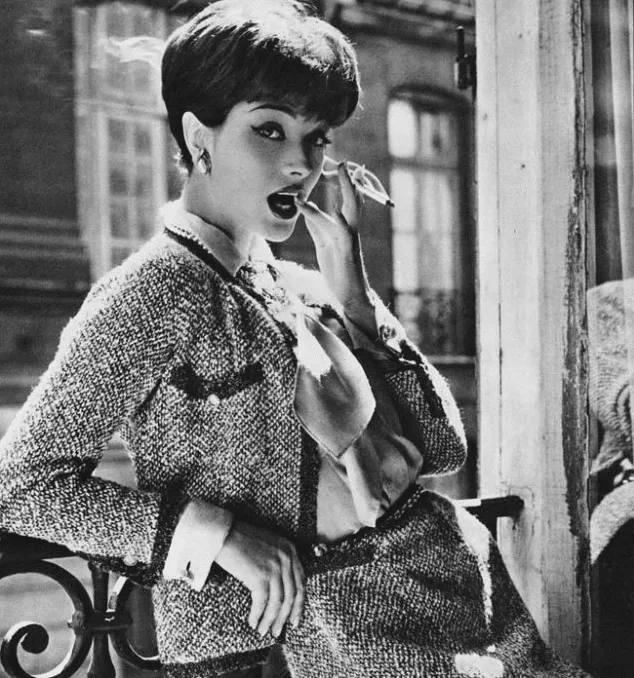In the early 20th century, women’s fashion was dominated by restrictive clothing like corsets, long skirts, and elaborate dresses. These garments emphasised modesty and femininity but also constrained women’s movement and comfort. Fashion dictated that women’s attire should be ornate and impractical, reflecting societal norms of the time.
Coco Chanel, born in 1883, grew up in poverty but had a keen eye for style and a rebellious spirit. She challenged the conventions of her time by introducing simplicity, comfort, and functionality to women’s clothing. Clean lines, neutral colors, and a rejection of excessive ornamentation characterized Chanel’s designs. Her innovative use of jersey fabric, traditionally used for men’s undergarments, gave her creations a sense of ease and modernity.
Table of Contents
Early Life and Influences
Coco Chanel’s early life was marked by hardship and resilience. Born Gabrielle Chanel on August 19, 1883, in Saumur, France, she was the second daughter of an itinerant peddler and a laundrywoman. Tragedy struck early when her mother passed away, leaving her father unable to care for the family. As a result, Chanel and her siblings were sent to an orphanage where she learned to sew, a skill that would later define her career.
Despite her humble beginnings, Chanel was determined to break free from the constraints of poverty. Influenced by the simplicity and practicality of men’s clothing, she began to challenge the extravagant styles of women’s fashion prevalent at the time. Her formative years were also shaped by her time spent in the company of wealthy individuals as a seamstress and cabaret singer, where she absorbed the tastes and lifestyles of the elite.
These early experiences instilled in Chanel a unique perspective on fashion, blending elegance with functionality. Her upbringing taught her the value of independence and innovation, qualities that would later propel her to the forefront of the fashion world.
Chanel’s Revolutionary Designs
One of Chanel’s most iconic contributions was the “Chanel style,” characterized by its clean lines, neutral colors, and understated elegance. She famously declared, “Simplicity is the keynote of all true elegance,” a mantra that guided her design philosophy. Chanel’s creations deviated from the elaborate and restrictive garments of the past, offering women a sense of freedom and confidence.
Central to Chanel’s vision was the introduction of the little black dress, a timeless classic that remains a staple in every woman’s wardrobe. Breaking away from the convention of brightly colored and heavily embellished dresses, Chanel popularized the idea of a simple, versatile black dress that could be worn for any occasion. This groundbreaking design symbolized a departure from traditional notions of femininity, embracing a more modern and independent woman.
Moreover, Chanel revolutionized women’s silhouettes by rejecting the corsets and voluminous skirts of the past in favor of more streamlined and comfortable designs. Her use of jersey fabric, previously reserved for men’s undergarments, further challenged gender norms and reinforced her commitment to practicality and ease of movement.
Breaking Fashion Norms
Breaking fashion norms was a hallmark of Coco Chanel’s revolutionary approach to design. Rejecting the rigid conventions of her time, she challenged traditional gender roles and introduced a new paradigm of style that emphasized comfort, practicality, and independence.
One of Chanel’s most notable contributions was her incorporation of menswear elements into women’s fashion. She borrowed from the wardrobes of men, integrating features such as tailored jackets, trousers, and crisp collared shirts into her designs. By blurring the lines between masculine and feminine attire, Chanel not only expanded the sartorial possibilities for women but also challenged societal perceptions of gender-appropriate clothing.
Furthermore, Chanel’s rejection of the corset, a symbol of constriction and oppression in women’s fashion, was groundbreaking. She advocated for a more natural and liberated silhouette, freeing women from the physical constraints imposed by traditional undergarments. Her designs prioritized freedom of movement and comfort, empowering women to embrace their bodies without compromise.
In breaking fashion norms, Coco Chanel paved the way for a more inclusive and progressive approach to style. Her defiance of conventional standards continues to inspire designers to push boundaries and challenge stereotypes, leaving an indelible mark on the evolution of fashion and gender expression.
Chanel’s Impact on Accessories
Chanel’s impact on accessories was profound and far-reaching, extending beyond clothing to redefine the way women adorned themselves.
Central to Chanel’s accessory legacy was her introduction of the iconic Chanel handbag. In 1955, she revolutionized handbag design with the now-famous Chanel 2.55, named after its launch date. Featuring a quilted design inspired by jockey’s coats and a chain-link shoulder strap for hands-free convenience, the 2.55 was both functional and stylish. Chanel’s handbags became synonymous with luxury and sophistication, cementing her reputation as a trailblazer in accessory design.
In addition to handbags, Chanel left an indelible mark on jewelry. She popularized costume jewelry, using faux pearls, crystals, and gold-plated metals to create pieces that were both affordable and chic. Chanel’s designs often featured timeless motifs such as the interlocking C’s, camellias, and lions, reflecting her love for classic elegance with a modern twist. Her jewelry collections became coveted accessories, adding a touch of glamour to any ensemble.
Furthermore, Chanel’s impact on accessories extended to fragrance. In 1921, she introduced Chanel No. 5, the world’s first designer perfume. Its bold yet refined scent, housed in a minimalist bottle, revolutionized the fragrance industry and set a new standard for luxury perfumery. Chanel No. 5 remains an iconic symbol of sophistication and femininity, illustrating Chanel’s enduring influence on every aspect of women’s style, from clothing to accessories to fragrance.
Chanel’s Influence Beyond Fashion
Beyond clothing, Chanel played a pivotal role in women’s liberation. Her designs represented a departure from the restrictive and impractical garments of the past, offering women a sense of freedom and empowerment. By championing simplicity, comfort, and functionality, Chanel encouraged women to embrace their individuality and reject societal norms that confined them to narrow roles and expectations.
Moreover, Chanel’s unconventional lifestyle and personal ethos challenged conventional notions of femininity. She embodied a modern, self-assured woman who defied societal conventions and pursued her ambitions with unwavering confidence. Chanel’s independent spirit and entrepreneurial success served as an inspiration for generations of women, demonstrating that they could carve out their paths and achieve greatness on their terms.
Furthermore, Chanel’s impact extended to the arts, influencing not only fashion but also literature, film, and visual arts. Her collaborations with artists and intellectuals of her time, such as Pablo Picasso and Jean Cocteau, helped to shape the cultural landscape of the 20th century. Through her innovative approach to design and her embrace of modernity, Chanel became a symbol of avant-garde creativity and sophistication.
FAQs
Did Coco Chanel face any challenges in her career?
Despite her eventual success, Coco Chanel faced numerous challenges throughout her career. She battled against societal norms that favored traditional, extravagant styles and initially struggled to gain acceptance for her more streamlined designs. Additionally, her upbringing in poverty and early setbacks, such as the death of her mother and time spent in an orphanage, presented significant obstacles on her path to success.
What were some key elements of Chanel’s design philosophy?
Chanel’s design philosophy was centered on simplicity, functionality, and innovation. She believed in stripping away excess and focusing on clean lines, neutral colors, and practicality. Chanel famously stated, “Fashion fades, only style remains the same,” emphasizing the importance of timeless elegance over fleeting trends.
How did Chanel’s personal life influence her designs?
Chanel’s personal experiences greatly influenced her designs. Her upbringing in poverty instilled in her a desire for simplicity and practicality, while her time spent among the elite exposed her to the world of luxury and refinement. Additionally, her relationships with influential figures, such as lovers and artists, often inspired her creative vision and shaped her aesthetic sensibilities.
What is Chanel’s legacy in the world of fashion?
Chanel’s legacy in the world of fashion is monumental. She revolutionized women’s clothing by introducing comfort and functionality, challenging traditional gender roles, and redefining notions of femininity and elegance. Her iconic designs, including the little black dress and Chanel suit, remain influential to this day, continuing to inspire designers and fashion enthusiasts around the world.
How did Chanel’s impact extend beyond fashion?
Chanel’s influence extended beyond fashion into the realms of culture, society, and the arts. She embodied a modern, independent woman who defied societal expectations and pursued her ambitions with confidence. Additionally, her collaborations with artists and intellectuals helped to shape the cultural landscape of the 20th century, leaving an indelible mark on literature, film, and visual arts.
Conclusion
Coco Chanel changed women’s fashion forever. Her designs were different, making clothes simpler and more comfortable. She believed that fashion should be easy and practical, not just about looking pretty.
Chanel’s ideas still influence fashion today. The little black dress she made is still popular, and her suits are timeless. But she didn’t just change clothes; she changed how women thought about themselves. She showed that women could be strong, independent, and stylish all at once.







